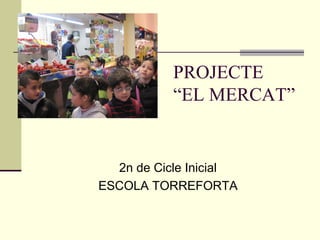Projecte mercat
- 1. PROJECTE ŌĆ£EL MERCATŌĆØ 2n de Cicle Inicial ESCOLA TORREFORTA
- 2. Comencem amb la detecci├│ dels coneixements previs sobre el barri i les botigues. Apareixen diferents conceptes, entre ells : la biblioteca, lŌĆÖesgl├®sia, ŌĆ” i el mercat. Qu├© en sabem del mercat ? Voleu investigar-ho ?
- 3. Coneixem el mercat dŌĆÖuna altra ciutat. ’ü« Activitats Jclic : El mercat un espai per descobrir: http://clic.xtec.cat/db/jclicApplet.jsp?project=http://cli
- 4. ’ü« Veiem que hi ha diferents parades agrupades per aliments : parada de peix,ŌĆ”Aix├▓ ens porta a parlar de la classificaci├│ dels aliments. ’ü« Els proposem una activitat de classificaci├│ dŌĆÖaliments que els conduir├Ā a crear la pir├Āmide aliment├Āria. ’ü« ├ēs una activitat realitzada per parelles.
- 6. Activitats TIC Aprofitant que tenim PDI realitzem les seg├╝ents activitats : ’ü« http://www.edu365.cat/infantil/monperunforat/ mercat/mercat.html ’ü« Vocabulari, frases i di├Ālegs. ’ü« http://laviladelsdretsdelsinfants.dretsinfant.cat /web/default.aspx
- 7. EXPRESSI├ō ORAL Fem de venderors/es i botiguers/es Despr├®s dŌĆÖhaver realitzat en lŌĆÖactivitat TIC vocabulari i di├Ālegs relacionats amb el mercat, ara ens toca practicar-ho a classe. En gran grup es fa una pluja dŌĆÖidees dŌĆÖun possible di├Āleg entre comprador/a i venedor/a.
- 11. EXPRESSI├ō ORAL Fem de venderors/es i botiguers/es
- 12. Tria de les fruites ’ü« Cada classe tria tres fruites. ’ü« Mitjan├¦ant votacions, es tria les tres fruites m├®s votades. ’ü« 2on A:Taronges, maduixes i pomes ’ü« 2on B: Mandarines, pl├Ātans i maduixes
- 13. Quines s├│n les vostres tres fruites preferides ?
- 14. Aproximaci├│ de preus Demanem a les fam├Łlies els preus dŌĆÖun quilo de cada una de les fruites escollides. Posteriorment, en gran grup, fem un buidatge a classe i establim un promig del preu de cada fruita.
- 16. Sortida al mercat ’ü« Anem a con├©ixer lŌĆÖedifici i a practicar el di├Āleg comprant les fruites que vam escollir. Estem molt il┬Ęlusionats. ’ü« Formem tres grups, un per cada fruita: Grup de les maduixes, grup dels pl├Ātans i grup de les mandarines. Cada grup tindr├Ā un fullet├│ per complimentar amb diferents dades:
- 18. A dins del mercat...
- 19. Maced├▓nia Qu├© hav├Łem de fer amb tanta fruita ? .... Doncs, una maced├▓nia... mmmMMMM
- 20. Juguem a botiguetes ’ü« Hem practicat el di├Āleg, hem comprat al mercat, hem menjat la fruita i ara toca jugar una mica... ’ü« Anteriorment hav├Łem demanat a les fam├Łlies envasos buits de diferents aliments : llet, iogurts, aig├╝es,sucs,oueres,...
- 21. Instruccions del joc : ’ü« Vam agrupar als alumnes en grups cooperatius de quatre nens/es. ’ü« Cada cinc minuts an├Āvem rotant un venedor/a i tres compradors/es. ’ü« Hav├Łen de seguir les pautes del di├Āleg i el c├Ālcul de la compra en euros.
- 23. Convidem una experta peixatera ’ü« Aprofitant que la mare dŌĆÖuna alumna de 2n B ├®s peixatera al mercat municipal li demanem la seva col┬Ęlaboraci├│ per fer-li dues entrevistes, una a cada classe. ’ü« En gran grup, cada classe, elabora un llistat de possibles preguntes. ’ü« Se li passa el llistat a la mare per a que prepari lŌĆÖentrevista.
- 24. Entrevista ’ü« Vam repartir les preguntes. Cada nen/a era responsable de fer la pregunta i escriure la resposta en un full petit.
- 25. Reciclatge ’ü« Amb tants dŌĆÖenvasos per les botiguetes, qu├© podem fer ? Doncs, reciclar-ho. ’ü« Es van repartir els diferents envasos entre tots els nens/es i per torns van classificar-ho en : cartr├│ i envasos. ’ü« Posteriorment amb un grup de quatre nens/es vam llen├¦ar-ho al contenidor corresponent.
- 27. Avaluaci├│ ’ü« Es considera molt positiu haver treballat amb diferents agrupaments : individual, per parelles, per grups cooperatius i en gran grup. ’ü« Els nens/es han estat molt motivats/des. ’ü« El fet dŌĆÖestar m├®s implicats ( actius ) en lŌĆÖaprenentatge ├®s un factor condicionant a la motivaci├│.
- 28. ’ü« Implica un treball molt exhaustiu per part del mestre. ’ü« No sŌĆÖhan treballat totes les compet├©ncies ( compet├©ncia art├Łstica ) ’ü« Hem millorat respecte a dŌĆÖaltres anys ( que realitz├Āvem el projecte ) en la participaci├│ directa dŌĆÖuna mare a lŌĆÖaula.
- 29. ’ü« LŌĆÖentorn s├▓cio-cultural de lŌĆÖescola condiciona lŌĆÖaportaci├│ dels materials demanats a lŌĆÖagenda: - A nivell dels materials reciclats van portar-ne molts. - A nivell de la consulta de preus hi va haver molt poca participaci├│. ’ü« Els espais i la infraestructura han estat els adequats.
- 30. Propostes de millora ’ü« Incloure una autoavaluaci├│ dels alumnes per tal de que quedin reflectits aquells aspectes a millorar i a potenciar. ’ü« Coordinar-nos amb lŌĆÖespecialista dŌĆÖeducaci├│ art├Łstica.


































































































